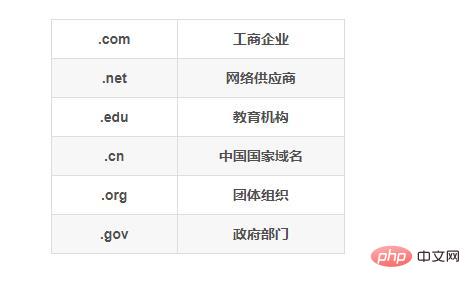 Operation and Maintenance
Operation and Maintenance
 Linux Operation and Maintenance
Linux Operation and Maintenance
 Which is the linux dns configuration file?
Which is the linux dns configuration file?
Which is the linux dns configuration file?
The linux dns configuration file is "/etc/resolv.conf". This configuration file is used to configure the DNS client. It contains the domain name search order of the host and the address of the DNS/server. Each line includes a keyword and one or more spaces separated parameters.

#The operating environment of this tutorial: linux5.9.8 system, Dell G3 computer.
Which is the linux dns configuration file?
In Linux, the configuration file of the DNS server is "/etc/resolv.conf".
/etc/resolv.conf file is used to configure the DNS client. It contains the domain name search order of the host and the address of the DNS/server. Each line includes a keyword and one or more space-separated parameters. .
Basic introduction to DNS:
1. Introduction to DNS
DNS (Domain Name System) means domain name resolution server. It is an application layer protocol. A service of the Internet. As a distributed database that maps domain names and IP addresses to each other, it can make people access the Internet more conveniently. The DNS service uses port 53 of TCP and UDP. TCP port 53 is used to connect to the DNS server, and UDP port 53 is used to resolve DNS. The length limit for each level of domain name is 63 characters, and the total length of the domain name cannot exceed 253 characters.
2. The role of DNS
Forward analysis: Find the corresponding IP address based on the domain name
Reverse analysis: Check the corresponding domain name based on the IP address
3. DNS domain name structure

1) The root domain
is located at the top level of the tree structure, and is represented by "."
2) Top-level domain
generally represents a type of organization or country region

3) Second-level domain
is used to indicate A specific organization within the top-level domain. The second-level domain names under the national top-level domain are uniformly managed by national departments. For example: .net.cn
. .edu.cn
. com.cn
4) Sub-domain/third-level domain
The domains at all levels created under the second-level domain are collectively called sub-domains. Each organization or user can freely apply to register their own domain name
5) Host
The host is located at the bottom of the domain name space and is a specific computer
Host name: www
# There is a many-to-one relationship between domain names and IP addresses. An IP address does not necessarily correspond to only one domain name, and a domain name can only correspond to one IP address
4. DNS server type
1 ) The main domain name server
is responsible for maintaining all domain name information in a region. It is the authoritative information source for all specific information, and the data can be modified. When building a primary domain name server, you need to create the address data file for the area you are responsible for.
2) Secondary domain name server
When the primary domain name server fails, shuts down, or is overloaded, the secondary domain name server provides domain name resolution services as a backup service. The resolution results provided from the domain name server are not determined by yourself, but come from the main domain name server. When building a secondary domain name server, you need to specify the location of the primary domain name server so that the server can automatically synchronize the region's address database.
3) Cache domain name server
Only provides the caching function of domain name resolution results. The purpose is to improve query speed and efficiency, but there is no domain name database. It fetches the result of each domain name server query from a remote server and caches it to respond to subsequent queries for the same information. Caching name servers are not authoritative servers because all information provided is indirect. When building a cache domain name server, you must set the root domain or specify other DNS servers as the resolution source.
4) Forwarding domain name server
is responsible for local queries of all non-local domain names. After the forwarding domain name server receives the query request, it searches it in its cache. If it cannot find it, it forwards the request to the specified domain name server in sequence until the result is found, otherwise it returns a result that cannot be mapped.
Related recommendations: "
Linux Video Tutorial"
The above is the detailed content of Which is the linux dns configuration file?. For more information, please follow other related articles on the PHP Chinese website!

Hot AI Tools

Undresser.AI Undress
AI-powered app for creating realistic nude photos

AI Clothes Remover
Online AI tool for removing clothes from photos.

Undress AI Tool
Undress images for free

Clothoff.io
AI clothes remover

Video Face Swap
Swap faces in any video effortlessly with our completely free AI face swap tool!

Hot Article

Hot Tools

Notepad++7.3.1
Easy-to-use and free code editor

SublimeText3 Chinese version
Chinese version, very easy to use

Zend Studio 13.0.1
Powerful PHP integrated development environment

Dreamweaver CS6
Visual web development tools

SublimeText3 Mac version
God-level code editing software (SublimeText3)

Hot Topics
 What computer configuration is required for vscode
Apr 15, 2025 pm 09:48 PM
What computer configuration is required for vscode
Apr 15, 2025 pm 09:48 PM
VS Code system requirements: Operating system: Windows 10 and above, macOS 10.12 and above, Linux distribution processor: minimum 1.6 GHz, recommended 2.0 GHz and above memory: minimum 512 MB, recommended 4 GB and above storage space: minimum 250 MB, recommended 1 GB and above other requirements: stable network connection, Xorg/Wayland (Linux)
 Linux Architecture: Unveiling the 5 Basic Components
Apr 20, 2025 am 12:04 AM
Linux Architecture: Unveiling the 5 Basic Components
Apr 20, 2025 am 12:04 AM
The five basic components of the Linux system are: 1. Kernel, 2. System library, 3. System utilities, 4. Graphical user interface, 5. Applications. The kernel manages hardware resources, the system library provides precompiled functions, system utilities are used for system management, the GUI provides visual interaction, and applications use these components to implement functions.
 vscode terminal usage tutorial
Apr 15, 2025 pm 10:09 PM
vscode terminal usage tutorial
Apr 15, 2025 pm 10:09 PM
vscode built-in terminal is a development tool that allows running commands and scripts within the editor to simplify the development process. How to use vscode terminal: Open the terminal with the shortcut key (Ctrl/Cmd). Enter a command or run the script. Use hotkeys (such as Ctrl L to clear the terminal). Change the working directory (such as the cd command). Advanced features include debug mode, automatic code snippet completion, and interactive command history.
 How to check the warehouse address of git
Apr 17, 2025 pm 01:54 PM
How to check the warehouse address of git
Apr 17, 2025 pm 01:54 PM
To view the Git repository address, perform the following steps: 1. Open the command line and navigate to the repository directory; 2. Run the "git remote -v" command; 3. View the repository name in the output and its corresponding address.
 Where to write code in vscode
Apr 15, 2025 pm 09:54 PM
Where to write code in vscode
Apr 15, 2025 pm 09:54 PM
Writing code in Visual Studio Code (VSCode) is simple and easy to use. Just install VSCode, create a project, select a language, create a file, write code, save and run it. The advantages of VSCode include cross-platform, free and open source, powerful features, rich extensions, and lightweight and fast.
 How to run java code in notepad
Apr 16, 2025 pm 07:39 PM
How to run java code in notepad
Apr 16, 2025 pm 07:39 PM
Although Notepad cannot run Java code directly, it can be achieved by using other tools: using the command line compiler (javac) to generate a bytecode file (filename.class). Use the Java interpreter (java) to interpret bytecode, execute the code, and output the result.
 What is the main purpose of Linux?
Apr 16, 2025 am 12:19 AM
What is the main purpose of Linux?
Apr 16, 2025 am 12:19 AM
The main uses of Linux include: 1. Server operating system, 2. Embedded system, 3. Desktop operating system, 4. Development and testing environment. Linux excels in these areas, providing stability, security and efficient development tools.
 How to run sublime after writing the code
Apr 16, 2025 am 08:51 AM
How to run sublime after writing the code
Apr 16, 2025 am 08:51 AM
There are six ways to run code in Sublime: through hotkeys, menus, build systems, command lines, set default build systems, and custom build commands, and run individual files/projects by right-clicking on projects/files. The build system availability depends on the installation of Sublime Text.





